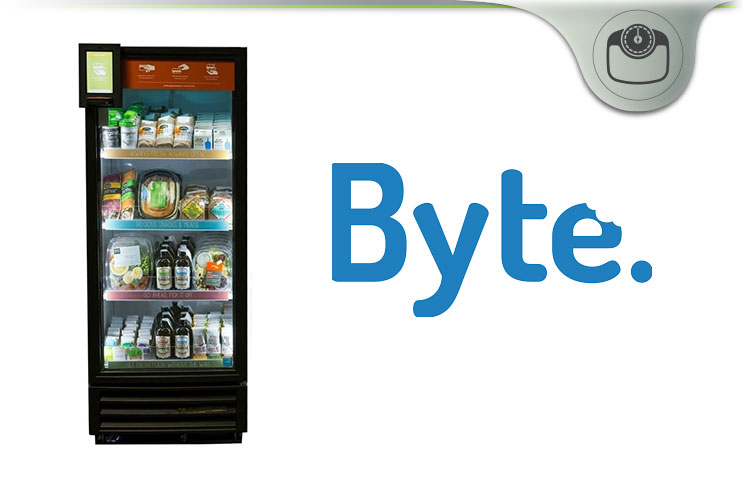Sick of looking at your office’s Byte Foods vending machine and deciding between Doritos and a KitKat bar? A startup called Byte Foods has been making headlines for its plans to introduce smart, healthy vending machines to workplaces across America.
Byte Foods, based in San Rafael, California, recently raised $5.5 million in seed funding to help popularize its smart vending machines.
Early promotional images for the vending machines show machines stocked with BBQ chopped salads and apple juniper kombucha instead of cans of Coke and bags of chips.
What makes the vending machines “smart”? Well, like other smart machines today, Byte is connected to the internet and uses software to predict customer behavior.
Plenty of modern vending machines are connected to the internet today, although the majority are not. A report by Berg Insight showed that 1.5 million of the world’s 17 million vending machines are connected to the internet. Most, however, do not use any type of advanced proprietary software, which is why Byte sees potential for growth in the sector.
The company was launched by married co-founders Lee and Megan Mokri, who previously ran a business called 180 Eats. That business delivered chef-prepared meals to subscribers. The two got the idea for a smart vending machine after they saw a “smart refrigerated kiosk”.
That kiosk was made by a company called Pantry Retail, Inc. Lee Mokri, as explained in an interview with TechCrunch, saw the value of that kiosk:
“It just made a lot more sense to deliver a lot of meals at once to one place, versus a lot of individual meals to different doors.”
The two co-founders got their breakthrough when they licensed one of Pantry’s machines, then convinced a local office building to keep it on-site. Lee and Megan kept the machine stocked with foods and beverages the employees were actually willing to pay for.
How the Byte Foods Machines Work
One of the unique things about the Byte Foods vending machine is that the food isn’t locked away from customers. You’re free to open the door, examine the food, and pick it up in your hands before you buy it. You can read the ingredients and see if that sandwich is really as good as it looks.
There’s also a touch display on the top left-hand corner of the vending machine where you can scroll through menu information and pricing.
Each item has an RFID tag. If a customer carries away an item, then the machine will automatically detect which items were removed, and will then charge the card on file.
If you don’t have a card on file, then you can swipe your card through a card reader on the touchscreen to purchase any item.
Another Byte innovation is the use of surge pricing to help ensure every last item in the machine gets sold before it expires. Byte calls this “dynamic pricing”.
Byte has also developed its own software that predicts the demand for different items in different office buildings. This software also helps to manage vendor relationships (Byte has ongoing relationships with 1,000 vendors).
What Makes Byte’s Machines “Smart”?
Being connected to the internet is just one reason why Byte is calling its product a “smart” vending machine.
The other reason is because of the dynamic pricing we mentioned above, but also because of the software’s ability to track aggregate data about employees’ and their eating habits. The software will grow to learn the snacking habits of employees in a particular office building.
Byte bundles up all this data and lets corporations track it, giving them valuable insight into heir employees. Employees can subsidize and track aggregate data about how their employees eat during breaks. They also have the opportunity to participate in a meal perks program.
What does that mean in the practical sense? Well, some companies are already using Byte to reward employees who work late. Some companies use Byte to give employees free food and drinks when they’re working past a certain hour, for example.
Many small and medium-sized businesses can’t afford to have Google-quality on-site cafeterias, so Byte is seen as a good middle ground between cheap vending machines and full-scale cafeterias.
Another “smart” feature is that the software will let customers opt-in to receive notifications for deals on their favorite items, or get an alert when there’s a free sample of new food available.
Byte Raises $5.5 Million in Seed Funding
Byte successfully tested the machines in 2015. In 2016, after being impressed with the Pantry machines, lee and Megan Mokri rebranded their company as Byte Foods, then acquired Pantry in May 2016 in an all-stock deal.
By the end of 2016, Byte had raised $5.5 million in seed financing, attracting investors like Bolt and Bessemer Venture Partners with the help of Spring Creek Investment Management, a Philadelphia-based family fund that specializes in food and agriculture.
Byte appears to be prepared for rapid growth: Byte CEO Megan Mokri claims they already have plenty of requests to use and license the software around the world:
“Our tech doesn’t exist anywhere else. We have inbound requests from all over the world to either license it or use our service…”
Watch for Byte smart vending machines to appear in an office near you in the future. The company is planning to aggressively expand throughout the San Francisco Bay Area using an army of smart vending machines and temperature-controlled food delivery trucks. However, they don’t yet have a date for expanding out of the Bay Area.









